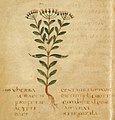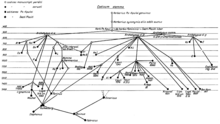
Quick Facts
Biography
Pseudo-Apuleius is the name given to the author of a 4th-century herbal known as Pseudo-Apuleius Herbarius or Herbarium Apuleii Platonici. He is not identical with Apuleius of Madaura (124–170), the Roman poet and philosopher. Little or nothing else is known of Pseudo-Apuleius apart from this. The oldest surviving manuscript of the Herbarium is 6th-century Leiden, MS. Voss. Q.9. Until the 12th century it was the most influential herbal in Europe, with numerous extant copies surviving into the modern era. Thereafter it was more or less displaced by the Circa instans, a herbal produced at the school of Salerno. "Pseudo-Apuleius" is also used as a shorthand generic term to refer to the manuscripts and derived works.
Pseudo-Apuleius Herbarius
Illustrations

Arnoglossa. Plantago. Ms. Voss. Lat. Qu. 9. Leiden. 6th century

Dragontea. Ms. Voss. Lat. Qu. 9. Leiden. 6th century

Centauria maior. Ms. Voss. Lat. Qu. 9. Leiden. 6th century

Centauria minor. Ms. Voss. Lat. Qu. 9. Leiden. 6th century

Caelidonia. Ms. Voss. Lat. Qu. 9. Leiden. 6th century

Nymp[h]ea. Ms. Voss. lat. Qu. 9. Leiden. 6th century

Arnoglossa. Plantago. Codex Vind. 93, Vienna. 13th century

Drag[on]tea. Codex Vind. 93, Vienna. 13th century

Centauria maior. Codex Vind. 93, Vienna. 13th century

Centauria minor. Codex Vind. 93, Vienna. 13th century

Chelidonia. Codex Vind. 93, Vienna. 13th century

Ni[m]fea. Codex Vind. 93, Vienna. 13th century

Plantago. Arnoglossa. Print. Rome 1481

Dracontea. Print. Rome 1481

Centauria [maior]. Print. Rome 1481

Centauria minor. Print. Rome 1481

Celidonia. Print. Rome 1481

Nymphea. Print. Rome 1481
Text
The text of Pseudo-Apuleius herbarius is based on late antique sources, especially on historia naturalis of Pliny and on de materia medica of Dioscorides. Scholars agree that the herbarius was compiled in the 4th century, according to Sigerist (1930, p. 200) from Latin, according to Singer (1927, p. 37) from Greek sources. Each of the 128 up to 131 chapters of the book (the number varying between manuscripts) dealt with one medical plant. In these chapters the name of the plant was followed by the enumeration of indications in the form of recipes and by synonyms of the plants name.
For example: Chapter 89, Herba millefolium (Edition of Howald/Sigerist 1927):
| Text (Howald/Sigerist 1927) | Translation |
|---|---|
| Herba millefolium | The herb millefolium [now interpreted as Achillea millefolium] |
| 1. Ad dentium dolorem. Herbae millefolium radicem ieiunus conmanducet. | 1. For toothache. The root of the herb millefolium should be chewed before breakfast. |
| 2. Ad uulnera de ferro facta. Herba millefolium cum axungia pistata et inposita uulnera purgat et sanat. | 2. For wounds inflicted by iron. If you put on the herb millefolium crushed in fat, so it cleans and heals wounds. |
| 3. Ad tumores. Herbam millefolium contusam cum butiro inpone. | 3. For tumours. Put on the herb millefolium crushed in butter. |
| 4. Ad urinae difficultatem. Herbae millefolium sucus cum aceto bibitur, mire sanat. | 4. For difficulties of urination. The juice of the herb millefolium drunk mixed with wine vinegar, heals wonderfully. |
| Nomina herbae. A Graecis dicitur miriofillon, alii ambrosiam, alii ciliofillon, alii crisitis, Galli mulicandos, alii uigentia, Daci diodela, Itali millefolium, alii militaris, alii Achillion, alii supercilium Veneris, alii cereum siluaticum. Hanc herbam Achilles inuenit, unde ferro percussus sanabat, quae ob id Achillea uocatur, de hac sanasse Telephium dicitur. | Names of the herb. The Greeks call it miriofillon, others ambrosia, others ciliofillon, others crisitis. The Gauls [call it] mulicandos, others vigentia. The Dacians [call it] diodela. The Italians [call it] millefolium, others militaris, others Achillion, others supercilium Veneris, others cereum silvaticum. This herb was discovered by Achilles because it healed wounds, beaten by iron. It was therefore named Achillea. |
| [Interpolationes ex Diosc.] Nascitur in palustris locis … | [ Interpolations from de materia medica of Dioscorides.] It grows in swampy areas … |
Manuscripts


In the codices the Pseudo-Apuleius Herbarius was combined with other treatises:
- De herba vettonica. Treatise dealing with the herb Stachys officinalis. It was falsely ascribed to Antonius Musa, physician of the Roman emperor Augustus.
- Pseudo-Apuleius Herbarius.
- De taxone liber. Anonymous treatise on the use of the European badger in medicine.
- Liber medicinae ex animalibus ascribed to an unknown Roman physician named "Sextus Placitus Papyriensis".
- A-version with 12 chapters about quadrupeds.
- B-version with 31 chapters about quadrupeds, birds, reptiles, spiders, insects and humans.
- (Pseudo-)Dioscorides de herbis femininis. According to Riddle written before the 6th century in South-Europe.
- Precatio terrae matris (Incantation of the mother of earth) and Precatio omnium herbarum (Incantation of all herbs).
Howald and Sigerist (edition 1927, V–XVI) divided the codices into 3 classes (α, β and γ) according to the varying mixture of these treatises in the codices:
- α-class containing parts 1, 2, 3, 4a and 5, moreover better synonyms than in the β-class-texts and no interpolations. The α-class is considered to be the class with the best text-tradition.
- β-class containing parts 1, 2, 3, 4b, 5 and 6, moreover interpolations. The ß-class is considered to be the class with the best illustrations.
- γ-class containing parts 1, 2 and 6, without the interpolations of the β-class. γ-class contains the oldest manuscripts.
| Class | Abbreviation (Howald/Sigerist) | Name of the codex | Century |
|---|---|---|---|
| α | Ca | Monte Cassino, Archivo de la Badia, Cod. 97 | 09th century. |
| α | M | Munich, Bayrische Staatsbibliothek, Fragmenta Emeranensia, Clm 14672, 14766 und 15028, in all 8 pages. | 07th century. |
| α | L | Lucca, Bibliotheka Governativa, MS. 296 | 09th century. |
| α | Hal | Halberstadt, Domschatz (Bibliothek des Domgymnasiums), Inv.-Nr. 465–466 fol. Ir–IIv, Palimpsest (upper writing). | 07th century. |
| α | Be | Berlin, Staatsbibliothek Fragmentum Berolinense Ms. Lat. fol. 381 no. 1 | 08th century. |
| α | Ha | London, British Museum, MS Harley 4986 | 12th century. |
| α | V | Vienna, Codex Vindobonensis 187 (nach Grape-Albers 1977, p. 3: Eton College MS. 204) | 12th century. |
| α | A | London, British Library, MS Cotton Vitellius C. iii | 11th century. |
| β | Hil | Hildesheim, Beverinsche Bibliothek, MS. 658 | 08th century. |
| β | Vr | Bratislava, Codex Vratislaviensis Bibl. univ. III F 19 | 09th century. |
| β | Bodley 130 | Oxford, Bodleian Library, MS. Bodley 130 | 11th century. |
| β | He | Herten, Codicis medici Hertensis, destroyed by fire | 09th century. |
| β | B | Bamberg, Codex Bambergensis med 8 (L III.15) | 13th century. |
| β | Laur. 7341 | Florence, Bibliotheca Laurenziana, MS. 73,41 | 09th century. |
| β | Va | Vatican, Codex Vaticanus Barberinus 160 | 11th century. |
| β | Vat. Lat. 6337 | Vatican, Codex Vaticanus lat. 6337 | 15th century. |
| β | Laur. 7316 | Florence, Bibliotheca Laurenziana, MS. 73,16 | 13th century. |
| β | Vi | Vienna, Österreichische Nationalbibliothek, Herbarium Apuleii Platonici|Codex Vindobonensis 93 | 13th century. |
| β | Arsenal 1031 | Paris, Bibliothèque de l’Arsenal, Codex 1031 | 15th century. |
| β | Paris 6862 | Paris, Bibliothèque Nationale, MS. lat. 6862 | 10th century. |
| β | Ber | Berlin, Codex Berolinensis Hamil. 307 | 15th century. |
| γ | E | Fragmentum Epporigiense | 07th century. |
| γ | Vo | Leiden, Universitätsbibliothek, MS. Voss. Lat. Q. 9 | 06th century. |
| γ | C | Kassel, Landesbibliothek, 2° MS. phys. et hist. nat. 10 | 10th century. |
Singer (1927), Grape-Albers (1977, pp. 2–5) and Collins (2000) cited more manuscripts:
- St. Gallen, Stiftsbibliothek, Cod. 217, 9th century.
- London, British Museum, MS. Harley 585, 11th – 12th century.
- London, British Museum, MS. Harley 1585, 12th century.
- London, British Museum, MS. Harley 5294, 12th century.
- London, British Museum, MS. Harley 6258 B, 12th century.
- London, British Museum, MS. Sloane 1975, 12th century.
- Oxford, Bodleian Library, MS. Ashmole 1431, 11th century.
- Oxford, Bodleian Library, MS. Ashmole 1462, 12th century.
- Turin, Bibliotheca Universitaria, MS. K IV 3, 11th century, destroyed by fire.
Several more manuscripts can be added (see Mylène Pradel-Baquerre 2013 and Claudine Chavannes-Mazel 2016):
- Leiden, University Library, MS BPL 1283, c 1300 (related to Lucca)
- Leiden, University Library, MS Voss.Lat.Qu. 13, 10th century (Anglo-Saxon group)
- Leiden, University Library, MS Voss.Lat.Qu. 40, 11th century (German group)
- Montpellier, Bibliothèque de l'Ecole de Médecine, MS 277, 15th century
- The Hague, Museum Meermanno-Westreenianum MS 10 D 7, 10th century (alpha group)
Incunabula and early printings
Based on a 9th-century manuscript of Monte Cassino the first incunable of Pseudo-Apuleius Herbarius was printed in Rome in 1481.
The first printing in northern Europe was done 1537 in Zürich.
Editions
- (London, British Library, MS Cotton Vitellius C. iii – 11. Jh. - as groundwork for this edition.)
- Kai Brodersen (2015). Apuleius, Heilkräuterbuch / Herbarius, Latin and German. Marix, Wiesbaden. ISBN 978-3-7374-0999-5


















